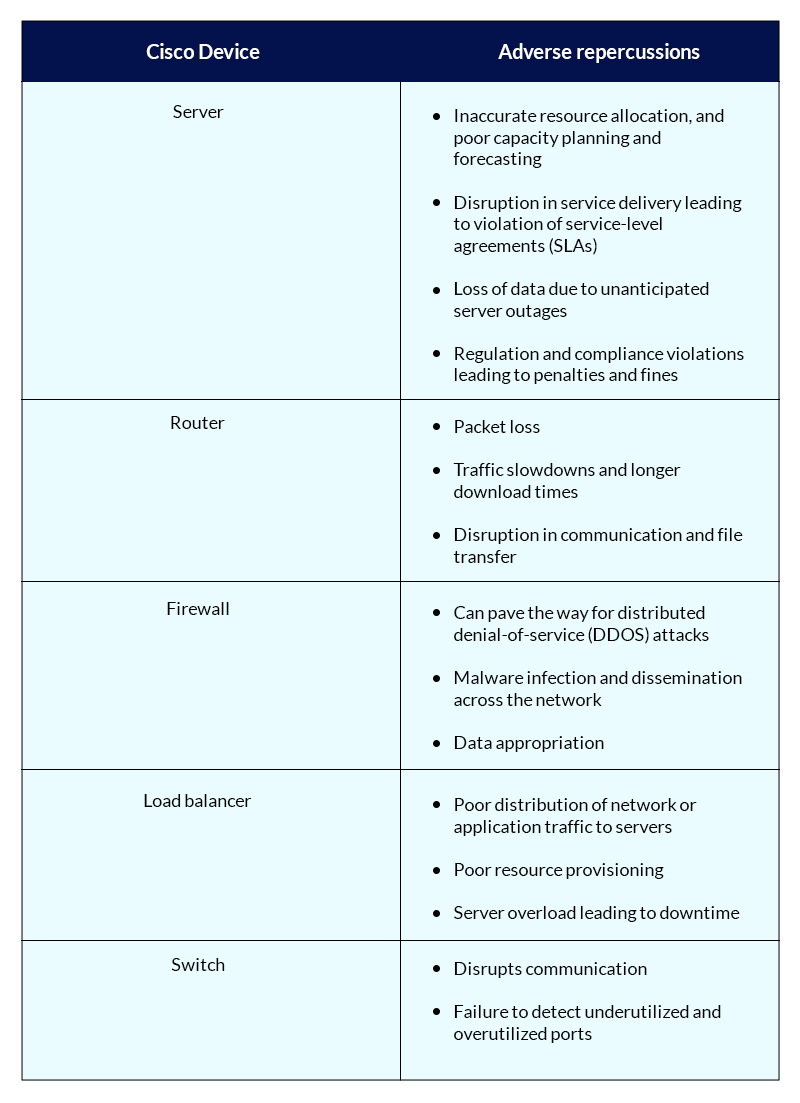An 8-point checklist to get Cisco management right

Cisco, one of the first companies to debut in the networking space, has given rise to radical and revolutionary technologies, inventions, and innovations that have helped set the stage for modern-day networking. Contemporary networks house an abundance of Cisco network components and employ manifold Cisco network technologies, making Cisco an integral part of their core network infrastructure.
With the profound dependence of business networks on Cisco infrastructure, any malfunction or outages of Cisco devices can impact organizations on multiple fronts. The repercussions can range from disruptions in service delivery to slumps in operational efficiency and productivity, blows to revenue, and more.
To avert these consequences, organizations should invest in Cisco management tools with comprehensive network management capabilities. These tools help network administrators gain complete visibility and control over networks, and monitor them end-to-end for performance and availability.
Cisco mismanagement: What could possibly go wrong?
Cisco devices are omnipresent, and are used across all parts of an organization's network. From network security and storage to internal and external communication, Cisco devices serve a plethora of purposes. Given the significant proportion of Cisco devices in an organization's network, it's highly likely that a malfunction in any one of these devices can severely cripple network operations.Here are some prominent roadblocks that can surface when the following Cisco devices are poorly managed:
Cisco management: A one-size-fits-all checklist
Considering the various network bottlenecks that emerge due to poor management of Cisco devices, it's imperative that organizations invest in a Cisco management tool with comprehensive network management capabilities. These tools can help streamline management, and enable network administrators to gain complete visibility and control over their organization's Cisco network infrastructure.With a myriad of tools available in the market, it can be daunting to zero in on the right one. With that in mind, here's a checklist of characteristics that an optimum tool should possess for effective management:1. Device discovery and inventory management
Before even thinking about management, it's crucial to identify all Cisco devices in your network. Maintaining an inventory of the devices, along with all relevant details such as device type, category, vendor, IP address, status, etc., will keep you abreast of all the happenings in your network.2. Proactive performance and availability monitoring
Cisco devices are susceptible to performance degradation over time, and require consistent monitoring to spot performance bottlenecks. Critical metrics such as memory, disk, and CPU utilization; data transmitted; temperature; I/O transactions; and more should be constantly monitored to avert potential network glitches.3. Fault detection, isolation, and reporting
Detecting and isolating faults from other events in the network is vital. Quickly identifying the root cause of a fault will help reduce the mean time to repair (MTTR) and can hasten fault resolution. Also, classification of faults based on severity levels is critical, as it helps with prioritization. Faults, once identified, need to be reported to the concerned personnel over multiple channels to expedite troubleshooting.4. Multi-device compatibility and support
Cisco devices come in all shapes and sizes, literally! Given the substantial number of types and models of Cisco devices in the market, organizations should invest in a tool that supports most Cisco models and other major vendors.5. Graphical visualization of network components
With business networks transcending across boundaries by being spread across multiple branch offices and distributed over an organization's infrastructure, it becomes increasingly difficult to manage them. Visual representation of network topologies and network components can help identify relationships and dependencies between these devices, which in turn can help spot faults quickly and hasten troubleshooting.6. Automated maintenance and troubleshooting
Cisco infrastructure management can be mundane. The management of network devices involves a lot of repetitive tasks, which can get laborious unless the organization has a sizeable workforce to deal with them. Automation in Cisco management can save a lot of time for network administrators, and can reduce the possibility of human error. Routine maintenance and troubleshooting tasks, if automated, can free up time for network admins to focus on more critical tasks.7. Performance and health reporting
Apart from real-time monitoring of your Cisco infrastructure, it's crucial that you analyze the historical performance and health stats of the devices. Weekly or monthly performance and health reports can paint a more holistic picture of your device's performance. The data from these reports can help you identify patterns or trends, which in turn can be used to make more informed decisions.8. Customizable dashboards
To get an overview of your Cisco infrastructure's performance or to analyze the performance of only specific components in your network, it helps to track all the critical and pertinent metrics in one place. Switching across tabs to view the performance of critical metrics is inefficient and cumbersome; a dedicated and customizable dashboard can offer a bird's-eye view of your network's performance at a glance, helping you better manage your network.Simplify Cisco management with OpManager
ManageEngine OpManager is a comprehensive network management tool for monitoring your Cisco environments' performance, health, and availability around the clock. Besides monitoring Cisco devices, OpManager also monitors the performance of WAN links and VoIP calls between remote sites using Cisco's IP SLA technology. With IP SLA, OpManager monitors critical parameters like Jitter, latency, packet loss, RTT, and more to determine network performance.OpManager's capabilities include, but aren't limited to, the following:Seamless device discovery
Real-time performance and availability monitoring
WAN link and VoIP monitoring using Cisco IP SLA
Foolproof fault management and reporting
Multi-vendor and device compatibility
Vivid network visualization and mapping
Drag-and-drop workflow builder for automation
Performance and health reporting
Customizable dashboards and widgets